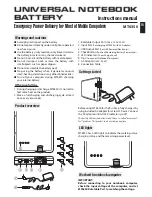
EWB100 Usage and Deployment Guide
Rev 1.13
Page 58
11 Profiles
11.1
Introduction to Profiles (rev J changes)
Profiles are a means to change a large number of configuration parameters for
the device in a single step. Most of the user visible configuration parameters are
set on a per-profile basis; when one switches profiles, one can change many
configuration parameters at once. The rationale for profiles is there could be
differences in configuration for various departments, jobs, or roles (lumber,
cashier, plumbing, manager, etc) and so when a particular user selects a device,
they select the proper profile for their job, role, or department.
Profiles can be used to implement something as simple as a WTT channel
switching mechanism simila
r to the “channel” knob on a conventional walkie
talkie.
Alternatively profiles can be used to replace the English language prompts with
those in other languages. A given device could support prompts in up to 8
different languages.
There are 8 (10 in Rev J) possible profiles with profile 0 being the default one.
Users may switch between profiles (if the profile switching is enabled). One of the
profiles is the default profile (normally profile 0 but any profile can be the default)
and it will be loaded upon startup. If profile switching is not enabled, then the
default profile will always be used. The default profile is set via a configuration
parameter. The device will switch to the default profile at startup time and
whenever it is placed into the charging cradle.
If profile switching is enabled, there are several ways of rotating through profiles.
The first approach involves pressing a button to enter profile switching mode and
then pressing the button repeatedly to rotate through enabled profiles. The
device will say the audio prompt associated with the profile. The desired profile is
then selected via a second button sequence. If the user does not select a profile
after a period of time, the device will timeout and continue using the current
profile. Typically in this mode, profile switching is entered by a single click of the
SAPP with additional clicks of the SAPP used to move among the various
profiles. A single click of the FAPP is typically used to “select” the current profile,
if such a mode is enabled.
The second approach also involves pressing the SAPP button to enter the profile
selection process and then repeatedly pressing that button to rotate through
profiles, hearing the name of each profile in the process. In this approach, the
device will
adopt whatever the profile that was last “heard” by the user. For this
mode “timeout” equals profile selection.
Which mode is used to select new profiles is defined on a per profile basis.
Summary of Contents for TEAM Badge (EWB100)
Page 12: ...EWB100 Usage and Deployment Guide Rev 1 13 Page 12 ...
Page 37: ...EWB100 Usage and Deployment Guide Rev 1 13 Page 37 ...
Page 39: ...EWB100 Usage and Deployment Guide Rev 1 13 Page 39 ...
Page 49: ...EWB100 Usage and Deployment Guide Rev 1 13 Page 49 set pr rxwttmask 0 z where z 1 x 1 1 y 1 ...
Page 57: ...EWB100 Usage and Deployment Guide Rev 1 13 Page 57 ...
Page 134: ...EWB100 Usage and Deployment Guide Rev 1 13 Page 134 Wait while the driver installs Wait ...
Page 146: ...EWB100 Usage and Deployment Guide Rev 1 13 Page 146 ...
















































